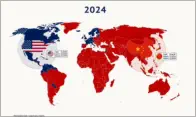



President Trump Slaps 125% Tariff
on China as Global Trade Lines
Redraw:
75 Nations Side with U.S.
President Trump announced a significant escalation in the ongoing trade
conflict with China, responding to China’s move to sharply increase tariffs on
U.S. goods. China’s Finance Ministry confirmed it would raise its retaliatory
tariffs from 34% to 84% beginning the following day. In response, Trump
stated, “I’m hereby raising the tariff charged to China by the United States of
America to 125% effective immediately.” This was framed as a direct response
to what he described as a lack of respect China has shown toward global
markets.
Trump emphasized that this shift was not merely punitive, but strategic. He
explained that the United States had received outreach from more than 75
countries that chose not to retaliate against the U.S. tariffs. As a result, he
authorized a 90-day pause on higher tariffs for those countries and lowered
reciprocal tariffs to just 10% during this period. “These countries have not, at
my strong suggestion, retaliated in any way, shape, or form,” he said,
highlighting this as a diplomatic success.
Commentators aligned with the administration described the move as
transforming the situation from a narrative of “the world versus America” to “the
world versus China.” The strategy, according to insiders, was deliberate. “He
goated China into a bad position,” one speaker explained, adding that China’s
retaliation had painted them as bad actors in the eyes of the international
community. The U.S., by contrast, was presented as open to cooperation with
non-retaliating nations.
The video featured criticism of media outlets for misinterpreting Trump’s
strategy. “Many of you in the media clearly missed the art of the deal,” said one
commentator. They argued that, contrary to media predictions, countries were
not aligning more closely with China but instead reaching out to the United
States to maintain access to American markets. “They need our markets, they
need our consumers, and they need this president in the Oval Office to talk to
them,” he added.
Businessman and investor Kevin O’Leary strongly endorsed the tariff
escalation. He argued that 125% tariffs were still not enough and advocated for
a 400% rate. “They cheat, they steal IP, I can’t litigate in their courts,” he said,
recounting his personal experiences doing business in China. O’Leary claimed
that China has routinely violated trade rules since joining the World Trade
Organization and has harmed American innovators by stealing intellectual
property, copying designs, and flooding markets with knockoff products.
The segment included a visual breakdown of global trade dynamics from the
year 2000 to 2024, illustrating how China has expanded its influence
economically. It was argued that China doesn’t need military action to
dominate; economic control is sufficient, and the use of trade barriers has been
one of their most powerful tools.
Overall, the Trump administration’s tariff policy was framed as a major turning
point in U.S.-China relations. The announcement marks a dramatic shift in the
global economic landscape, sending a clear message to allies and adversaries
alike. According to the presenters, the goal was not only to protect American
jobs and industries but to force a long-overdue reckoning with China’s trade
practices—something they claim previous administrations failed to do.
125% Tariff on China
75 Nations Side with U.S.


USA - News
Tariffs have been employed by countries as far back as 2000 - 1000 BC
•
Ancient Mesopotamia, Egypt, and Greece used early forms of tariffs as far back as
2000 - 1000 BC.
•
The Roman Empire imposed customs duties (portoria) at provincial borders and
ports.
•
Tariffs were often a key source of government revenue before income taxes
existed.
•
European kingdoms imposed tolls and duties on goods crossing their borders.
•
Trade guilds and cities used tariffs to protect local industries and control imports.
•
15th–18th Centuries (Mercantilism Era)
•
Countries like England, France, and Spain heavily used tariffs to:
o
Protect domestic production and Increase national wealth.
o
Maintain a trade surplus
Tariffs were central to colonial economic policies.
19th Century
Industrializing nations, like the U.S. and Germany, used high tariffs to protect young
industries (called "infant industry protection").
The UK, under pressure from free trade advocates, repealed the Corn Laws (1846)
and led the push for lower tariffs globally.
In the 20th Century, tariffs peaked in the 1930s during the Great Depression (e.g., U.S.
Smoot-Hawley Tariff Act).
After WWII, nations began reducing tariffs under agreements like:
•
GATT (1947) – General Agreement on Tariffs and
•
Trade & WTO (1995) – World Trade Organization
In the 21st Century, tariffs are still used, especially in trade disputes (e.g., U.S. - China
trade war).
Most countries now favor lower tariffs to encourage global trade but may still impose
them to:
•
Protect key industries
•
Respond to unfair trade practices.
•
Enforce sanctions
The History of Tariffs
Copyright © 2025 globalgrype.com
All rights Reserved
Global Tariff Negotiations
USA’s Trade Deficit
China
$383.0 billion in 2022 : $279.4 billion in 2023 : $295.4 billion in 2024
Canada
$78.2 billion in 2022 : $64.3 billion in 2023 : $63.3 billion In 2024


Blue = USA Red = China
TARIFFS
These maps show how China’s global trade has expanded from 2000 to 2024